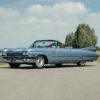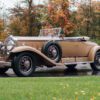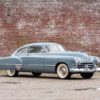Cadillac Models & History 1978
Subtle exterior changes dominated 1978, as wheelbases and dimensions were virtually identical to 1977. DeVille, Brougham, limo and Eldorado had a bolder horizontal crosshatch grille. All but Eldorado had new rear bumper ends with vertical taillamps and three-dimensional crest insignia, Most broughams, all California Cadillacs and the fuel-injected DeVille sedan sported aluminum hoods. After the start of production, Elk Grain vinyl tops would be used on all except Seville, which retained a padded Tuxedo Grain vinyl top. Passenger compartments had seven new interior colors and three new body cloths, including Random velour. Of the 21 body colors, 17 were new and all but two of those were exclusive to Cadillac. Signal-seeking AM/FM stereo radios were now standard on all Cadillacs. For the first time, chromed wire wheels from the British firm of Dunlop were offered as options on DeVille, Brougham, and Seville models. New electronic level control (standard on all except DeVille) used a height sensor to signal a motor-driven compressor that automatically adjusted for changing loads. The transmission had higher downshift speeds this year. DeVille and Brougham body mounts were retuned for a smoother, quieter ride. Four new special editions were offered:
- Seville Elegante
- Phaeton Coupe (or Sedan) DeVille
- revised Eldorado Custom Biarritz.
An available diesel V-8 engine (built by Oldsmobile) for Seville was announced during the model year, at the Chicago Auto Show. So was a new electronic trip computer. All Cadillacs except Seville carried a standard 425 cu. in. V-8. Cadillac hardly tried to hide the boast that owning one had always “expressed success.” As the full-line catalog modestly proclaimed, “calling something ‘the Cadillac of its field’ is one of the finest compliments you can pay a product.”
For 1978, there were five models:
- DeVille (two-door coupe and four-door sedan)
- Fleetwood Brougham (four-door sedan)
- Fleetwood Limousine (four-door sedan, four-door formal limousine, and commercial chassis used in hearses and ambulances, etc.)
- Eldorado (two-door hardtop coupe)
- Seville (four-door sedan)
| I. D. DATA |
|---|
- Cadillac’s 13-symbol Vehicle Identification Number (VIN) again was located on the forward edge of the windshield trim molding, visible through the windshield.
- Coding was similar to 1978.
- The model year code changed to “S” for 1978.
- Engine coding was now as follows:
- “B” V8-350 EFI
- “S” V8-425 4 Bbl.
- “T” V8-425 EFI
- “N” V8-350 diesel
| HISTORICAL |
|---|
- Introduced: September 29, 1977.
- Model year production (U.S.): 349,684 for a 3.9 percent share of the industry total and the second highest Cadillac total ever.
- Calendar year production (U.S.): 350,761.
- Calendar year sales by U.S. dealers: 350,813 for a 3.8 percent market share.
- Model year sales by U.S. dealers: 347,221.
- Record sales greeted Cadillac for the third year in a row.
- The model year total beat 1977’s mark by 6 percent.
- The new Seville diesel (engine built by Oldsmobile) sold only about 2,800 copies, barely half the early prediction.
- But it was introduced late in the model year.
- Sevilles in general hit a new production high.
- Eldorado did well also, as buyers snapped up the last of the vast Eldos before the 1979 downsizing.
- A three-month shutdown of the Linden, New Jersey plant, to tool up for the new E-body 1979 Eldorado, Toronado and Riviera models, contributed to a loss in calendar year production of DeVilles this year.
- Cadillac asserted that the company “consistently leads all U.S. luxury car makes in repeat ownership. Once you own a Cadillac,” they suggested, “it is difficult to accept anything less.”
 |
|---|







